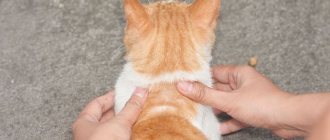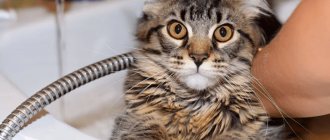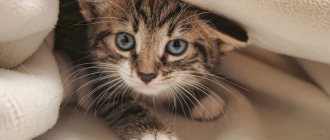Veterinarian tips for feeding cats
Veterinarian tips for caring for cats:
- Cats need to be fed meat, but not very fatty, dairy products. Meat should be given to cats raw, at least every other day, after scalding the piece with boiling water. With raw meat, cats receive the bioflavonoids necessary for their predatory body, which are needed for metabolic processes. Without raw meat, cats may get sick and lose their fur.
- These animals are big lovers of meat, such as: chicken, beef, veal, minced meat, chicken gizzards and necks and liver. All this can be fed to cats. Veterinarians recommend giving liver to cats 1-2 times a week, after pouring boiling water over it.
- If you feed your cat liver very often, it can lead to hypervitaminosis (excess of vitamins) A and D vitamins.
- Also, cereals and vegetables are very useful for cats, but not every cat will eat it. Therefore, study your pet to see which cereal or vegetable does not disgust him, and mix it into his food.
- If you managed to teach your cat to eat cereals and vegetables, then this is only a plus. You can cook different porridges, except for rolled oats (it contributes to disruption of carbohydrate metabolism in cats).
- You can also add vegetables to the porridge, both boiled and raw, simply grated. Raw vegetables, like raw meat, are also very necessary for the cat's body. Beans, tomatoes and eggplants are contraindicated for cats. Vegetables can be served with meat, without cereals.
- also needs to take special vitamins , they can be in the form of tablets, or place a pot of special grass next to the bowls, which contains all the vitamins necessary for cats.
- Be sure to remember to provide fresh, clean water .
- Cats can be given only 1-2 eggs per week, no more, as this destroys biotin, which is responsible for the health of the coat. Lack of biotin leads to hair loss.
- Nowadays, on store shelves we are offered a large assortment of dry ready-made cat food, but not all of them are healthy. Veterinarians recommend choosing food at a high or medium price; it contains a large percentage of meat and all the substances and vitamins necessary for the health of cats.
- Cheaper food does not contain meat at all; instead of animal protein, it uses vegetable soy protein, which can cause stones in cats.
Healthy nutrition is good for cats too.
What should you not feed your cat? What do veterinarians advise not to give to cats?
Not everything can be fed to a cat; many foods are very dangerous. Let's look at the list of these products.
Veterinarian tips for caring for cats:
- Many people think that fish is a cat's favorite treat, but this is not true. Fish is harmful to them; it contains a lot of protein, which increases the load on the animal’s kidneys, thereby destroying the mineral balance, after which urolithiasis begins.
- Feeding cats only fish will cause a deficiency of vitamin K, which will lead to poor blood clotting. In addition, the fish may be infected with parasites. Therefore, if you decide to pamper your pet with fish, choose sea fish and feed it once a week, maximum twice.
- You should not give cats flour products and legumes, they cause flatulence in the animal and intestinal upset.
- You can't feed cats pork; it's too fatty for them. Fatty foods cause obesity of internal organs in cats, and pork meat can also contain parasites.
- You also shouldn’t let the food you give your cat have any seasonings.
- Make sure that cats do not get to indoor plants, as they can be poisonous.
Veterinarians advise not to feed cats everything.
How to accustom a cat to a new home: advice from a veterinarian
Veterinarian tips for caring for cats:
- If you cannot imagine life without a pet and decide to get yourself a pet, then veterinarians advise adopting an animal at the age of 10-12 weeks. At this age, the pet begins to get used to the person.
- When you bring your furry pet into your home, the bag or basket in which the animal was brought does not need to be removed immediately. Place it in a corner until the cat adapts to the new place, it will be a refuge for it, the cat will use it more than once. Place the necessary vessels in a place visible to your pet - a bowl for food and water, a tray where the cat will go to the toilet.
- Food bowls should be made of materials that are easy to clean, and the litter tray should be spacious, 5-10 centimeters high. For convenience, the bottom of the tray can be filled with special granules - fillers, sawdust or torn paper. This kind of filler is easy to replace, but it’s better not to use sand; throwing it down the toilet can clog the pipes in your house.
- With the advent of a new home, the cat may behave very warily, hide in a corner or, on the contrary, sniff everything. At such a moment, the animal experiences great stress; a person must help the pet survive this stage. At such a moment, the person himself should be calm, not scream, not behave aggressively while the pet gets used to the new place.
- Try to spend a few days as much time as possible with the new family member, pay more attention to him and then the adaptation period will end much faster.
For a cat to be happy, you just need to love it.
At what age is it better to adopt a kitten?
The decision about at what age to buy a pet fluffy is, of course, up to you; each decision has its pros and cons.
If you want to have a pet from an early age, then be prepared for the fact that you will have to devote a lot of your time to the kitten. The entire future life of the animal depends on the quality of care, conditions of detention, nutrition and education.
You should buy a kitten at the age of at least 12 weeks, since kittens are too young and still need maternal care and are not ready for independent life away from their mother, either psychologically or physiologically.
How to accustom a cat to your house: advice from a veterinarian
Cats need to be raised with love and care, like small children, and therefore, keeping them requires a lot of effort and adaptations to ensure that your pet can feel comfortable in the home. Let's take a closer look at them.
Cat house . The cat needs to be taught to go to the toilet and eat in strictly designated places, but it is important that the pet has its own corner for sleeping and resting. There are special houses for cats and cats that greatly simplify keeping such pets in the house. With the appearance of a cat house in your apartment, your nights will be calmer, without a cat on your pillow, it will be easy for you to find him in the apartment. A cat may not immediately start living in a house, since the cat family is very conservative, they need time to get used to it.
Veterinarian tips for caring for cats:
- Size. A house for a pet must be selected according to size; if it is too large or small, the pet may refuse to spend time in it.
- Smell. A new home shouldn't smell like glue or the cheap material it's made from. Animals have a keener sense of smell than humans. If the house smells strongly, your pet will refuse to live in it.
- House upholstery. Take a closer look at your pet, what material does it lie on most often at home, maybe it’s your terry robe or shirt. The most common material is carpet or plush; it is soft and does not electrify. If your pet has some kind of favorite bedding, then you can put it in his house, so he will get used to it faster.
- The place where the house will stand. This should be a quiet and secluded place, not on the aisle. Cats love to be near a radiator, so the house can be installed near a heating device; you should not place it too close, as overheating will cause the animal to shed.
- Sustainability . The pet's home must be carefully secured. Cats are afraid of structures that shake. Once scared, your furry friend will never go there again.
- Special conditions. Males are cats, they are protectors and must monitor the situation around them; their house should have several tiers. Females prefer to take care of their offspring, so they prefer closed, cozy homes.
- Functionality . Cats not only love comfort, but also show great interest in various designs. You can add tiers, a scratching post, or attach some kind of toy that your pet will enjoy playing with.
Praise your pet when he spends time in the house, give him treats, pet him. Cats love affection and they are very smart, affection and love are very important to them. This attitude towards the animal will quickly help it adapt to its new home and to you.
How to accustom a kitten to a litter tray, read the article: How to accustom a kitten and an adult cat to a litter tray or toilet?
Give a cat a home and you will see a look that will never betray you.
What to greet a kitten with
English folk wisdom says that, according to the cat, all things belong to cats. There is a grain of truth in this statement. But still, before you bring a kitten, you need to purchase several things that will belong exclusively to your future “relative”.
So - a small reminder “How to care for a cat and what should be purchased by the time a kitten appears in the house.”
Tray
No one has canceled natural needs and it is unlikely that anyone wants a kitten to relieve itself in an apartment, in a secret corner. Street cats, of course, do not know comfort, but indoor kittens (and especially their owners) need a proper cat litter box first and foremost.
In short, there are three types of trays:
- closed (so-called Eurotoilet);
- open with filler;
- open without filler with lattice;
The first (closed) are aesthetically pleasing, but expensive. This type of litter tray requires a gel or silica gel filler that blocks odor. The advantages of this type of tray are obvious - they are discreet, tidy and pleasant in appearance. One of the disadvantages is the large size of the toilet, for which there may simply not be room in the house!
The open type of tray with filler is the most common and, perhaps, convenient for apartments and for a four-legged baby. Recommendations from “experienced” people are unanimous that there is no need to buy a small tray for a kitten. Regardless of age, the baby will overcome the high sides and you will save on constantly changing toilets. So immediately buy a tray “for growth”, especially since any fillers are suitable for this type and they are very easy to disinfect.
Advice to purchase a tray without filler with a grid is addressed to those who are constantly at home and can often rinse the grid and the tray itself. From time to time, flush the toilet with special products containing chlorine, and may the absence of odor and a happy kitten be with you!
Read how to train a kitten to use the litter box.
There are also special trays for accustoming a kitten to a human toilet.
Read how to train a kitten to use the toilet.
In the video you can learn the general rules for those who don’t mind sharing a “white friend” with their animal:
Toilet filler
Keeping a kitten will be comfortable for both of you if the kitten likes the litter, in a figurative sense, of course. Although, if you observe a one-month-old kitten, you will find that he will probably try the filler on his tooth.
There are three types of fillers:
- locking;
- clumping;
- absorbent.
The burying instinct, inherent in the kitten by nature, should be realized at the moment when he “powdered his nose.” Therefore, do not skimp on the filler, let the baby dig up enough and, therefore, enjoy going to the toilet.
Locking fillers are considered the most economical This filler is poured in large quantities into a tray, moisture flows down the granules and is absorbed only in the lowest layer. The top layers remain clean and prevent odor from spreading. When most of the surface turns yellow, the filler is refreshed.
Clumping filler dissolves with moisture, forming round clumps. They are removed with a special sifting spatula, and filler is added as needed.
Absorbent fillers are the most inexpensive and environmentally friendly. They are made mainly from sawdust, paper, etc. You can also remove it in parts, as it gets dirty.
Dishes
Let the Saxon porcelain set continue to stand in the sideboard, as a memory of your great-grandmother - for the kitten you need to purchase only three bowls in advance (by the way, porcelain ones are also possible). One bowl is needed for water. It should be as stable as possible. The other two are for dry food and for liquid food. Bowls should be easy to clean and comfortable for the kitten.
If you are often away from home for long periods of time, we advise you to buy an automatic feeder and a drinking fountain.
scratching post
If you don’t buy a scratching post or put off this purchase until “later,” then you will have to buy a new sofa or leather corner for the kitchen. And it’s not about the cat’s harmfulness at all! Kitten cats don't just sharpen their claws. This ritual is an exercise for them, without which the animal feels uncomfortable. There will be no scratching post - the baby will replace it with furniture or wallpaper. From the first day, take the baby to a special post or even a complex wrapped in sisal thread, and show the kitten what to do with this happiness.
To consolidate the effect, spray the scratching post with liquid catnip, which is so attractive to cats.
A little patience will ultimately save your furniture and nerves! Try making a cat scratching post with your own hands according to the video instructions.
Combs
Yes, on the dressing table of a decent kitten there should be a comb, or better yet several at once - the rule of caring for kittens. Of course, if your pet is not a sphinx or a charming greyhound. Human hair care products are absolutely not suitable for babies! Plastic combs are also not suitable for them, since they strongly electrify the fur.
Metal scratchers with wide teeth are optimal. Brushes that fit on your hand are very convenient.
IMPORTANT! Try not to use slickers, better known as slickers! They are needed in preparation for exhibitions, and in normal, non-show mode, the kitten’s fur can be greatly damaged by the slicker.
Toys
The baby needs toys. Like any baby, a cat child will look for a toy. It could be a gold ring left out of habit under the mirror or a torn button. Therefore, buy a couple of toys in advance. Balls, fur mice, rattles or feathers on a stick will help the kitten brighten up the first days of separation from its mother cat. Or make your own cat toys.
Sprays
Caring for a kitten for 1 month will be quite difficult. Until your patience and love develop acquired instincts in your baby. Special sprays can help with this! They can be repellent or habituating.
You will need the first ones to protect those places that the cat can damage or to wean her from going to the toilet in the wrong place.
Attraction sprays are good for crate training or house training.
These sprays are completely safe for the animal and very effective!
Carrying
Newborn kittens were initially handled by the breeder. From the moment he has handed over the banner of responsibility to you, you will have to visit the veterinarian regularly. Therefore, carrying is simply necessary. It can be fabric or plastic (depending on the size, temperament of the cat and the geography of transportation). For those who are going on a trip by train or plane, a hard plastic carrier is needed; traveling in a car is convenient with a soft carrier.
By the way, while the first trip is still looming in the future, it is convenient to use the carrier as a house for the baby. Place a diaper in it that smells like its first home and the kitten will feel safe in the carrier.
Toothbrush and toothpaste
Problems with teeth and gums in cats often lead to serious illnesses. You need to start caring for your baby’s oral cavity from a young age. Otherwise, later this procedure will be painful for everyone.
Beef or salmon flavored toothpastes and comfortable toothbrushes should relieve possible dental problems. It is very easy to care for a cat that has been accustomed to procedures since infancy.
The video below shows a short dental course:
How to accustom a cat to a scratching post: advice from a veterinarian
Veterinarian tips for caring for cats:
- If your cat begins to damage the furniture and it’s too late to trim its claws, then you urgently need to buy your pet a scratching post. First, you need to observe what place the pet began to spoil.
- If it is a jamb or a wall with wallpaper, then it is better to buy a scratching post with a carpet corner. Place it in the place where the cat began to scratch. At first, a cat may accept such equipment aggressively, but there are a few tricks that will help you accustom your pet to a scratching post.
- First, you need to pick up the pet, bring it to the scratching post and place its paw on it, then lightly press the paw so that the cat releases its claws, and move the paw from top to bottom. This trick needs to be done several times, maybe not in a row, but over the course of a day or several days.
- Secondly, they now sell special sprays for this method, mostly mint-based. You just need to spray the scratching post. Veterinarians advise not to use valerian, it is a drug for cats.
- For more information on this topic, read the article The cat is tearing up furniture: what to do? How to stop a cat from tearing up furniture: practical advice and radical methods .
Get your cat used to scratching posts from an early age.
How to care for claws
Domestic cats need to have their claws trimmed to keep their claws in order and to prevent them from injuring their owners during play.
It is enough to carry out the procedure a couple of times a month, using a special nail clipper or regular nail clippers.
Photo: nail care
Before starting the procedure, you need to wash your hands and treat the instrument with alcohol. It is important to choose a moment when the animal is in a calm mood. You need to pick him up and, with light pressure on the paw pad, force him to release his claws.
You need to trim the free edge of the claw, stepping back a couple of millimeters from the living part, equipped with blood vessels and nerves. It is pink in color and is clearly visible in the light. If necessary, you can file the cut edge.
Manipulations should be accompanied by gentle, soothing words. After processing each paw, you can take a short break.
Grooming: veterinarian advice
Veterinarian tips for caring for cats:
- Taking care of their fur plays a very important role in the health of cats. These animals are very clean; they lick their fur very carefully. Sometimes such efforts are not enough and therefore veterinarians strongly recommend helping cats in this matter.
- Combs and brushes, which can be purchased at a pet store, will help you care for your animal's fur. Try to examine your cats as often as possible to immediately identify any disease or parasites.
- Brushing your cats will make life easier not only for them, but also for you. The fur you comb out could end up on the sofa or on the floor throughout the apartment. When a cat licks itself, it eats its fur to get rid of this lump, the cat begins to cough, causing vomiting. This is normal.
- If the cat has short hair, then you need to comb it twice a week, and if the cat has long hair, then once a day, so that the hair does not roll up, otherwise you will have to remove this lump only with scissors. Try to brush your cats gently so as not to damage the skin.
A well-groomed coat is the key to a healthy cat.
More details on this topic in the article: The cat, the cat climbs a lot, loses hair all year round: the reason, the time of shedding. What to do, what to feed, what to give to a cat and a cat, how to care for a cat and a cat so that their hair does not come out?
Bathing cats
Veterinarian tips for caring for cats:
- In the wild, cats don't bathe unless it rains. The cat needs to be washed as it gets dirty. Of course, if a cat got into something, got dirty, and smells bad, then it needs to take a bath as soon as possible, and with antibacterial shampoo specially made for cats.
- If your cat has fleas, you need to wash it with flea shampoo. If the cat takes care of itself, washes itself, washes itself, then it is not necessary to bathe it every day. In cats and kittens, a film forms on the body, which has a protective function for the body.
- If you bathe your cat frequently, the film will begin to wash off, so it is better to bathe cats once every two weeks. For a pet that walks outside and comes into the house to spend the night, it is better to simply wash its paws and dry them with a towel that you have specially allocated for it.
- If you decide to give your cat a good bath in the bathroom, you should first plug his ears with cotton wool to prevent water from getting into them.
- If water gets into your pet's ears, he may develop a disease called otitis media. And also, make sure that the cat does not drink soapy water from the bath, this can cause stomach upset and poisoning.
- More details on this topic in the article: Do cats need to be bathed, and how often? How to properly wash domestic cats, cats and kittens and with what?
Bathe cats as they become dirty.
Walks in the open air
For walks in the fresh air, follow these rules:
- Walk with your child in city parks and squares, away from noisy and polluted roads.
- Prepare your animal to wear a harness in an apartment; gradually the cat will get used to this necessary accessory.
- You can take your cat outside only after vaccination.
- Do not allow your pet to communicate with yard cats, otherwise you can catch any infection.
- In winter, buy your cat appropriate clothes for walking.
Cat sterilization
Veterinarian tips for caring for cats:
- Neutering a cat means removing the ovaries. Cats can not only be spayed, but also neutered, removing all reproductive organs.
- A cat’s sexual desire can be suppressed with special drops or tablets, but they are hormonal and can harm the cat.
- Your cat needs to be spayed when she is 8 months old. Before surgery, it is better not to feed the animal for 5-6 hours, as veterinarians advise. It takes a long time for cats to recover from anesthesia, about a day.
- If after two days the cat is lethargic and has no appetite, then it is better to call a veterinarian at home. Do not forget to treat the seam; if it begins to ooze, then lubricate it with brilliant green or fucorcin.
- If your cat scratches or licks a stitch, distract her from doing so. A cat's sexual desire can last up to several weeks while sex hormones circulate through the body.
- Read more on this topic in the articles: Favorable period for sterilization of a cat and castration of a cat. Preparing a cat for sterilization and methods of sterilization, care after sterilization. Is it worth spaying a cat and neutering a male cat? What complications can there be?
We are responsible for those we have tamed.
Castration of cats
Veterinarian tips for caring for cats:
- Veterinarians advise castrating an animal at 9-10 months. If castrated earlier, the animal may develop problems with the urethra. It is necessary to castrate before the first mating.
- If you operate on the cat later, it will not help; after the operation, he will still want the cat. Because the sex hormone in cats is also produced by the pituitary gland and, if mating has already taken place, then the sex hormone will not escape from the cat’s body.
- After the operation, take good care of the cat, do not let him lick the stitch, put on a special circle so that he does not reach it. Let him drink more regular fresh water.
- Feed him food that is easy to digest; heavy food after surgery and lack of water in the cat's body can cause urolithiasis and obesity. Such procedures are done at the request of the animal’s owners; if you want offspring, you don’t have to do it.
Not only dogs are man's best friend, but cats too.
Cat diseases: advice from a veterinarian
All cats are susceptible to various diseases and infections, and it doesn’t really matter if they are indoor cats or go for walks outside. There are diseases that only affect cats, and others that are dangerous to humans. Such diseases are transmitted through close contact between an animal and a person. Let's look at what diseases are common in cats and humans.
Veterinarian tips for caring for cats:
- Rabies. This is a viral disease that can affect all animals, and therefore humans can also become infected with this disease. An animal can become infected from an infectious animal, or from a rodent that is a carrier of the disease. Signs of rabies include: refusal to eat, cats are afraid of light and water, their salivation increases, and they have become more aggressive. Basically, the virus in cats is in the mouth, and therefore it can be transmitted to humans from the bite of a pet. To prevent such a disease in an animal, it is necessary to undergo annual vaccination.
- Ringworm . This disease is fungal and therefore the causative agents of this disease are fungi. This is a skin disease that is characterized by peeling and redness of the dermis and in the animal. Mostly it happens on the head or on the front legs. At the first signs of illness, you must immediately take the animal to the veterinarian, get tested, and then follow the exact treatment prescribed by the veterinarian. The animal's recovery can last up to a month.
- Parasites. There are external and internal parasites. External parasites cause great discomfort to cats; they begin to itch frequently and severely. Such parasites are mainly found on the neck and stomach of the animal. They pose a great danger; through their bites they infect the animal with internal parasites - worms. Therefore, to begin with, veterinarians recommend removing external parasites; this can be done using special bathing products, and then begin removing worms. Just don’t delay treatment, this disease can be fatal for the animal. Read more in the articles: Worms in cats: causes, symptoms, treatment, prevention. What blood-sucking insects and parasites can live on a cat's body?
The list of diseases that cats can suffer from is very long. Some can be noticed immediately, but some can occur in a hidden form. Therefore, do not forget to take your cat for vaccination, inspect her fur more often, and generally take a closer look at her. If you suddenly notice something wrong, it is better to immediately contact a specialist. Don't be afraid to make furry friends, just follow some rules for keeping and caring for them and they will shower you with love.
Take care of animals, because for them you are the whole world.
How to understand that a cat is sick
These animals are very resistant to illness, so owners can easily not notice the symptoms of the disease until the disease reaches a severe stage.
10 signs indicating illness:
- Unusually frequent, too loud or guttural meowing.
- Licking a specific part of the body.
- The appearance of the third eyelid, squinted or closed eyes.
- The cat is hiding and does not want to be contacted.
- Breathing with your tongue hanging out.
- Aggression and irritability.
- Doesn't want to eat.
- Gives up favorite games.
- Goes to the litter box more often than usual or refuses to go to it at all.
- Unusual sweetness.
If you notice the above symptoms in your pet, contact your veterinarian.
Now you know what the care and maintenance of a cat involves and what responsibility you will take on when you bring a little cat into the house. Weigh all the pros and cons and only after that decide whether to take the baby.











